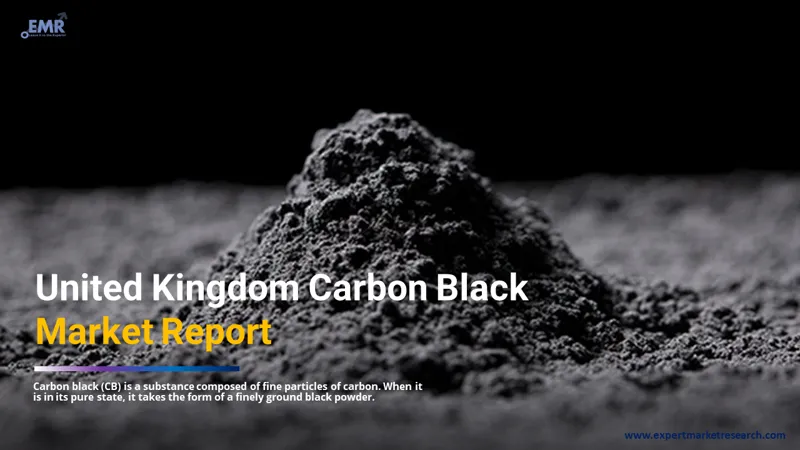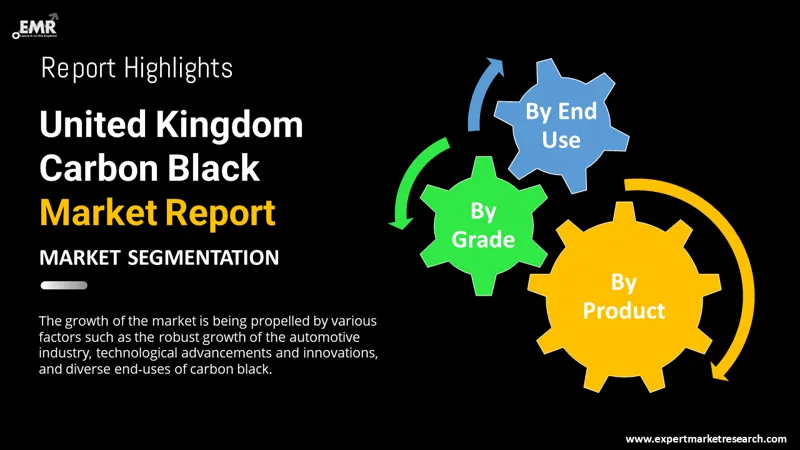
Consumer Insights
Uncover trends and behaviors shaping consumer choices today
Procurement Insights
Optimize your sourcing strategy with key market data
Industry Stats
Stay ahead with the latest trends and market analysis.
The United Kingdom carbon black market value reached USD 398.56 Million in 2025. The market is further expected to grow at a CAGR of 7.40% between 2026 and 2035 to attain nearly USD 813.84 Million by 2035.
Base Year
Historical Period
Forecast Period
Compound Annual Growth Rate
7.4%
Value in USD Million
2026-2035
*this image is indicative*
Carbon black (CB) refers to a material that typically contains fine carbon particles. In its pure form, it appears as a fine black powder. Different methods such as thermal black and furnace black are used to obtain CB. Moreover, it is used in various applications in the rubber, tyre, plastic, and paints and coatings sectors among others.
The increasing investments in chemistry expertise, production machinery, and laboratory equipment for manufacturing are likely to aid the United Kingdom carbon black industry growth. Moreover, leading companies are focusing on efficiently sourcing their raw materials to boost the production of high-quality rCB and expand their operations.

Read more about this report - REQUEST FREE SAMPLE COPY IN PDF
The United Kingdom carbon black market dynamics and trends include the rising adoption of electric vehicles and the expanded use of lithium-ion batteries. This trend is driving the increased use of carbon black to reduce charging times and enhance the energy density of these batteries.
The cost-effectiveness offered by CB is leading to a surge in its utilisation in plastic applications. Hence, its demand is expected to increase in the manufacturing of anti-static packaging boxes, plastic film sheets, ABS pipes, and non-pressure pipes among others.
London has exhibited the most significant growth in BEV registrations, with figures more than doubling from 2021 to 2022, reaching approximately 22% of new car registrations. This surge underscores the capital's aggressive push towards electric mobility, driven by stringent emissions regulations and the expansion of Ultra Low Emission Zones (ULEZ). Outside of London, BEV registrations also increased, albeit at a slower pace, with the rest of the UK seeing BEV adoption rise to about 12% by 2022. Cities like Birmingham, Bristol, Manchester, and Sheffield mirrored this national trend but lagged London, with BEV registration percentages ranging between 8% to 15% by 2022.
Hybrid vehicles have seen more widespread adoption across the UK during this period. In 2021, hybrid registrations across major cities like Manchester and Sheffield hovered around 25% to 28%, with London showing slightly lower figures at around 23%. By 2022, hybrid vehicle registrations in Manchester and Sheffield had surged to nearly 30%, indicating strong adoption of hybrid technology as an interim step towards full electrification. Meanwhile, London saw a steady increase in hybrid registrations, reaching about 26% by 2022. This growth in hybrid vehicles contributed to the United Kingdom carbon black market revenue, as carbon black, used as a conductive additive in lithium-ion batteries, plays a crucial role in these vehicles.
The regeneration of areas like Nine Elms in London has been a cornerstone of the UK's urban renewal efforts. This project alone has generated 25,000 new jobs, created 18,000 new homes, and added over 600,000 square meters of new office space, indicating a strategic approach to urban redevelopment that marries economic growth with infrastructure enhancement. The UK’s infrastructure expertise is further evidenced by its extensive road network and cutting-edge tunnel construction. The country maintains over 400,000 kilometres of publicly managed roads, facilitating the daily movement of 4 million vehicles. This extensive network is bolstered by ongoing development projects like the Crossrail initiative, which involves building 42 kilometres of new tunnels beneath London. This contributes to the growth of the United Kingdom carbon black industry revenue, as carbon black improves the durability and wear resistance of asphalt, essential for maintaining high-traffic roads and highways.
Waverly Carbon Ltd
Cabot Corporation
Tokai Carbon Co., Ltd
PanaSystem Handels GmbH

Read more about this report - REQUEST FREE SAMPLE COPY IN PDF
“United Kingdom Carbon Black Market Report and Forecast 2026-2035” offers a detailed analysis of the market based on the following segments:
Market Breakup by Products
Market Breakup by Grade
Market Breakup by End Use
The growth of the United Kingdom carbon black market is driven primarily by the transportation sector. The rising popularity of electric vehicles is increasing the demand for carbon black in lithium-ion batteries. As CB can improve the tread wear of truck tyres and boost their durability, it is also used to significantly lower costs in trucking applications.
The growing use of CB in pigmentation, resin, and resin applications in the industrial sector is augmenting the market growth. Meanwhile, the printing and packaging segment of the market is being fuelled by the increasing utilisation of high-performance CB in flexographic, lithographic, letterpress, screen printing, and gravure applications, among others.
Carbon black is used in decorative building bricks, blind track bricks, and jointing applications in the building and construction sector. The United Kingdom carbon black market demand is further being invigorated by the increasing demand for CB with excellent pigmentation, durability, and dispersion performance for colouring and filling applications in the building and construction sector.
The company’s focus on manufacturing premium carbon black for use in rubber, plastics, and electronics. They are recognized for their cutting-edge production techniques and dedication to sustainability and superior product quality.
United States Carbon Black Market
South Korea Carbon Black Market
Latin America Carbon Black Market
North America Carbon Black Market
Asia Pacific Carbon Black Market




*While we strive to always give you current and accurate information, the numbers depicted on the website are indicative and may differ from the actual numbers in the main report. At Expert Market Research, we aim to bring you the latest insights and trends in the market. Using our analyses and forecasts, stakeholders can understand the market dynamics, navigate challenges, and capitalize on opportunities to make data-driven strategic decisions.*
Get in touch with us for a customized solution tailored to your unique requirements and save upto 35%!
In 2025, the market attained a value of nearly USD 398.56 Million.
The market is projected to grow at a CAGR of 7.40% between 2026 and 2035.
The market is being aided by the robust growth of the automotive industry, technological advancements and innovations, and diverse end-uses of CB.
The significant grades of CB in the market are rubber grade and speciality grade.
The revenue generated from the carbon black market is expected to reach USD 813.84 Million in 2035.
The market is expected to be propelled by the rising demand for rCB, the growing popularity of electric vehicles, and the increasing development of innovative speciality grade CB.
Based on end use, the market is divided into industrial, building and construction, printing and packaging, transportation, and others.
The major products of CB in the market are furnace, acetylene, thermal black and others.
Carbon black is made from incomplete combustion of fossil fuels such as diesel, gasoline, and coal. Various methods, including furnace black and thermal black, among others, are used to obtain CB from such fossil fuels.
The surface-area-to-volume ratio of CB is lower than that of activated carbon. While CB is produced from incomplete combustion of petroleum, activated carbon is made up of carbon atoms and derived from charcoal.
The competitive landscape consists of Waverly Carbon Ltd, Cabot Corporation, Tokai Carbon Co., Ltd, and PanaSystem Handels GmbH, among others.
Explore our key highlights of the report and gain a concise overview of key findings, trends, and actionable insights that will empower your strategic decisions.
| REPORT FEATURES | DETAILS |
| Base Year | 2025 |
| Historical Period | 2019-2025 |
| Forecast Period | 2026-2035 |
| Scope of the Report |
Historical and Forecast Trends, Industry Drivers and Constraints, Historical and Forecast Market Analysis by Segment:
|
| Breakup by Products |
|
| Breakup by Grade |
|
| Breakup by End Use |
|
| Market Dynamics |
|
| Trade Data Analysis |
|
| Price Analysis |
|
| Competitive Landscape |
|
| Companies Covered |
|
Datasheet
One User
USD 2,499
USD 2,249
tax inclusive*
Single User License
One User
USD 3,999
USD 3,599
tax inclusive*
Five User License
Five User
USD 4,999
USD 4,249
tax inclusive*
Corporate License
Unlimited Users
USD 5,999
USD 5,099
tax inclusive*
*Please note that the prices mentioned below are starting prices for each bundle type. Kindly contact our team for further details.*
Flash Bundle
Small Business Bundle
Growth Bundle
Enterprise Bundle
*Please note that the prices mentioned below are starting prices for each bundle type. Kindly contact our team for further details.*
Flash Bundle
Number of Reports: 3
20%
tax inclusive*
Small Business Bundle
Number of Reports: 5
25%
tax inclusive*
Growth Bundle
Number of Reports: 8
30%
tax inclusive*
Enterprise Bundle
Number of Reports: 10
35%
tax inclusive*
How To Order

Select License Type
Choose the right license for your needs and access rights.

Click on ‘Buy Now’
Add the report to your cart with one click and proceed to register.

Select Mode of Payment
Choose a payment option for a secure checkout. You will be redirected accordingly.
Gain insights to stay ahead and seize opportunities.

Get insights & trends for a competitive edge.

Track prices with detailed trend reports.

Analyse trade data for supply chain insights.

Leverage cost reports for smart savings

Enhance supply chain with partnerships.

Connect For More Information
Our expert team of analysts will offer full support and resolve any queries regarding the report, before and after the purchase.
Our expert team of analysts will offer full support and resolve any queries regarding the report, before and after the purchase.
We employ meticulous research methods, blending advanced analytics and expert insights to deliver accurate, actionable industry intelligence, staying ahead of competitors.
Our skilled analysts offer unparalleled competitive advantage with detailed insights on current and emerging markets, ensuring your strategic edge.
We offer an in-depth yet simplified presentation of industry insights and analysis to meet your specific requirements effectively.
Share